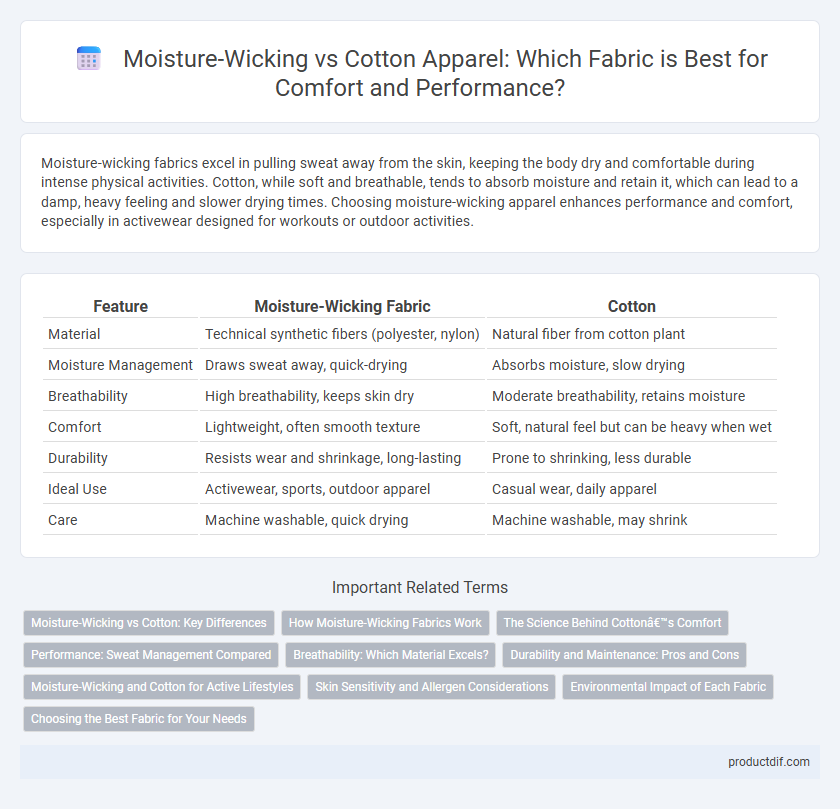Moisture-wicking fabrics excel in pulling sweat away from the skin, keeping the body dry and comfortable during intense physical activities. Cotton, while soft and breathable, tends to absorb moisture and retain it, which can lead to a damp, heavy feeling and slower drying times. Choosing moisture-wicking apparel enhances performance and comfort, especially in activewear designed for workouts or outdoor activities.
Table of Comparison
| Feature | Moisture-Wicking Fabric | Cotton |
|---|---|---|
| Material | Technical synthetic fibers (polyester, nylon) | Natural fiber from cotton plant |
| Moisture Management | Draws sweat away, quick-drying | Absorbs moisture, slow drying |
| Breathability | High breathability, keeps skin dry | Moderate breathability, retains moisture |
| Comfort | Lightweight, often smooth texture | Soft, natural feel but can be heavy when wet |
| Durability | Resists wear and shrinkage, long-lasting | Prone to shrinking, less durable |
| Ideal Use | Activewear, sports, outdoor apparel | Casual wear, daily apparel |
| Care | Machine washable, quick drying | Machine washable, may shrink |
Moisture-Wicking vs Cotton: Key Differences
Moisture-wicking fabrics, often made from synthetic fibers like polyester or nylon, are designed to draw sweat away from the skin, promoting faster evaporation and keeping the wearer dry and comfortable during intense physical activity. In contrast, cotton absorbs moisture and retains it, which can lead to a heavy, damp feeling and longer drying times. The key difference lies in moisture management; moisture-wicking materials enhance breathability and performance, while cotton offers natural softness but less effective sweat control.
How Moisture-Wicking Fabrics Work
Moisture-wicking fabrics utilize synthetic fibers such as polyester and nylon engineered to pull sweat away from the skin through capillary action, promoting faster evaporation and keeping the wearer dry. These materials often feature microfibers with hydrophobic properties that prevent moisture absorption, enhancing breathability compared to traditional cotton. This technology is essential in high-performance apparel, improving comfort and regulating body temperature during athletic activities.
The Science Behind Cotton’s Comfort
Cotton's natural fibers absorb moisture, allowing it to trap sweat away from the skin, which enhances breathability and comfort during moderate physical activity. Unlike synthetic moisture-wicking fabrics engineered to pull moisture to the surface for quicker evaporation, cotton's hydrophilic properties result in slower drying but provide a soft, breathable feel that is gentle on sensitive skin. This makes cotton ideal for casual wear or low-intensity activities where comfort and moisture absorption are prioritized over rapid drying.
Performance: Sweat Management Compared
Moisture-wicking fabrics outperform cotton in sweat management by quickly drawing moisture away from the skin and promoting rapid evaporation, keeping athletes dry and comfortable during intense physical activities. Cotton absorbs sweat but retains it, leading to dampness and increased chafing, which can hinder performance and cause discomfort. Advanced synthetic blends like polyester or nylon used in moisture-wicking apparel enhance breathability and reduce the risk of overheating, making them ideal for high-performance sportswear.
Breathability: Which Material Excels?
Moisture-wicking fabrics excel in breathability by actively drawing sweat away from the skin and promoting rapid evaporation, keeping the body cool and dry during intense physical activity. Cotton, while soft and comfortable, tends to retain moisture, which can lead to a damp, heavy feel and reduced breathability in comparison. For high-performance apparel, moisture-wicking materials provide superior airflow and moisture management, making them the preferred choice for breathability.
Durability and Maintenance: Pros and Cons
Moisture-wicking fabrics, often made from synthetic fibers like polyester or nylon, offer superior durability due to their resistance to shrinking, stretching, and fading, requiring less frequent washing to maintain performance. Cotton, while breathable and soft, tends to wear out faster with repeated washing, often shrinking or losing shape, which demands more delicate maintenance and careful laundering to extend garment lifespan. Choosing moisture-wicking apparel supports longevity and low maintenance, whereas cotton requires gentle care to prevent damage but provides natural comfort and biodegradability.
Moisture-Wicking and Cotton for Active Lifestyles
Moisture-wicking fabrics, such as polyester and nylon blends, excel in active lifestyles by rapidly drawing sweat away from the body to keep the skin dry and comfortable. Cotton, while soft and breathable, tends to absorb moisture, which can lead to a heavier, damp feeling during intense physical activity. For athletes or fitness enthusiasts, moisture-wicking apparel enhances performance and comfort by maintaining optimal body temperature and reducing chafing.
Skin Sensitivity and Allergen Considerations
Moisture-wicking fabrics, often made from synthetic fibers like polyester or nylon, are designed to pull sweat away from the skin, reducing irritation and minimizing the risk of allergic reactions for individuals with sensitive skin. In contrast, cotton, a natural fiber, is hypoallergenic and breathable but tends to retain moisture, which can lead to prolonged dampness and increased skin sensitivity or irritation. Choosing moisture-wicking apparel can enhance comfort and reduce allergens exposure for those prone to skin sensitivities, while 100% organic cotton remains a preferred option for its natural softness and reduced chemical treatment.
Environmental Impact of Each Fabric
Moisture-wicking fabrics, often made from synthetic fibers like polyester derived from petrochemicals, have a higher environmental footprint due to energy-intensive production and microplastic pollution during washing. Cotton, while natural and biodegradable, requires significant water, pesticides, and land use, contributing to soil degradation and water scarcity. Sustainable alternatives such as organic cotton and recycled polyester aim to reduce these environmental impacts by minimizing resource use and chemical inputs.
Choosing the Best Fabric for Your Needs
Moisture-wicking fabrics efficiently draw sweat away from the skin, keeping you dry and comfortable during intense physical activity, making them ideal for workouts and outdoor adventures. Cotton, known for its breathability and softness, excels in casual wear and low-intensity environments but tends to retain moisture, which can cause discomfort during heavy sweating. Selecting the best fabric depends on your activity level and environment, prioritizing moisture management for high-intensity and cotton for everyday comfort.
Moisture-wicking vs cotton Infographic

 productdif.com
productdif.com